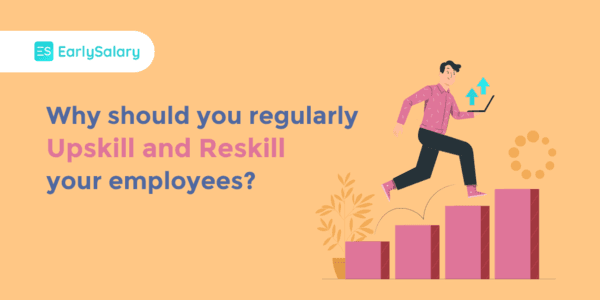Why Should You Regularly Upskill And Reskill Your Employees?
Reviewed by: Fibe Research Team
- Updated on: 10 Apr 2023
Reviewed by: Fibe Research Team

Highlight: Employee upskilling and reskilling usually don’t sound like a good idea at a time when businesses are battling to stay afloat, do they? Wrong.
It is a common misconception that employees must do what they must with their present talents amid difficult circumstances and not consider how to enhance their skill set. We’ve already seen the economic environment alter as a result of the Covid-19 outbreak, as well as the tough requirements and resources for innovative techniques to mobilize your existing talent pool.
Getting new hires to a good start is a challenge. A solution to the pandemic is to look inside and better prepare current staff for upcoming challenges. Professional development can help people achieve their professional goals both within and outside of their current employment. As a result, HR and L&D departments are being forced to bridge the skills gap independently. The potential benefits of skill-focused development encourage individuals throughout their careers and positively impact an organization’s overall performance.
Upskilling is described as the training that allows someone to get better at a job they already do. Reskilling is defined as developing different skills and new capabilities to assist someone shifts to a new career.
We need to understand why upskilling and reskilling are necessary, why it is important, and how we might do it.
Learners become a flexible force that can move and bend with any changes in your market as they continually respond to the market and develop new essential abilities.
As a consequence, staff will have a higher depth of knowledge and will be more used to problem-solving for what your industry and market want, allowing you to use their abilities to guide your company through troubled seas.
Since the outbreak, businesses have seen significant slowdowns and halts, necessitating rapid action to make them profitable, if not merely afloat. The worldwide epidemic has wreaked havoc on most industries, resulting in Coronavirus layoffs, hiring freezes, and furloughs.
Transportation, hotels, restaurants, oil and gas, and other important businesses are among those that have been impacted. Since then, our new normal appears to shift daily, and all of the new information we receive may make creating concrete goals seem even more demanding.
According to sources, unemployment went up to nearly 24 percent in April 2020. Between February and April 2020, the share of households that experienced a fall in income shot up to nearly 46 percent.
As the unemployment rate in rural and urban India climbed, almost 1.5 million workers in both the formal and informal sectors lost their jobs in August 2021, undoing some of the improvements gained in July.
During this crisis, the best firms can do is strive to maximize their present personnel to the best of their abilities and position themselves for success when things start to pick up. Holistic involvement of HR is crucial in this aspect.
Also read: Fix the Problem of Employee Burnout for your Remote Workers
One of the most rigorous methods to gain seniority or job stability in a firm is to seek new talents constantly, bridge any skill gaps, and look for ways to provide value to the organization.
How can you keep aiming for success if you’ve lately had to institute a hiring freeze to avoid layoffs?
One option is to upskill and reskill your staff to maximize their potential in their existing roles or take on new responsibilities when the company needs assistance.
Jobs that you were hiring for or that you had to let go of must still be completed. The skill sets required for job competencies that have not yet been hired are likely already present in your business or require modest skill development. Your employees should be able to wear numerous hats if necessary.
What’s to stop you from transferring your junior recruiters to business development for the time being if you’re on a hiring freeze but still require business development reps? You can reassign people to different jobs to meet the business’s needs, but it will involve some reskilling and peer-to-peer mentoring.
Companies can only thrive at times like these if they have adaptable, agile, and willing to learn.
Employers must focus on workplace education to close the skills gap, and 70 percent of businesses believe that tuition reimbursement/scholarships, university-sponsored discounts, and industry credentials are the most effective means for upskilling/reskilling.
The Wiley report “Reimagining the Workforce 2021,” which covers the views of CHROs, L&Ds, and CXOs, discovered this. “The most successful techniques for bridging the skills gap among employees are upskilling and reskilling,” they said.
Also Read: Understanding Employee Engagement: The Psychology at Work

Wellness programs by including internal communication and continued HR involvement can also drive employee strength.
What began as a commercial trend has evolved into a critical requirement of the hour. Reskilling and upskilling are proving to be the most effective ways to close the talent-skill gap in the labor market.
To learn more about the workplace environment and easy financial tips visit our blogs at Fibe.
Download the personal loan app here, or log in to our website and be a part of the #OneSmallStep experience